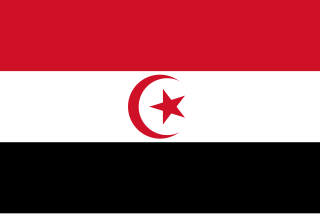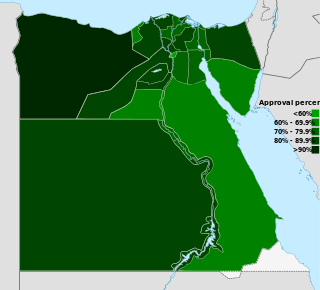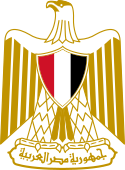
The politics of Egypt is based on republicanism, with a semi-presidential system of government, established following the Egyptian Revolution of 2011, and the resignation of President Hosni Mubarak. The President of Egypt is elected for a maximum of two four-year terms and the Parliament is unicameral and unbiased. The President can appoint up to 5% of the total number of seats in Parliament, and can also dissolve it. Parliament can also impeach the President. Egypt was traditionally ruled by royals until 1952, but the first free elected President was in 2006. The Parliament of Egypt is the oldest legislative chamber in Africa and the Middle East.

The United Arab Republic was a sovereign state in the Middle East from 1958 to 1971. It was initially a political union between Egypt and Syria from 1958 to until Syria seceded from the union after the 1961 Syrian coup d'état, leaving a rump state, while Egypt continued to be known officially as the United Arab Republic until 1971.

According to most scholars the history of modern Egypt dates from the emergence of Muhammad Ali's rule in the early 19th century and his launching of Egypt's modernization project that involved building a new army and suggesting a new map for Egypt.

The Arab Islamic Republic was a proposed unification of Tunisia and Libya in 1974, agreed upon by Libyan head of state Muammar Gaddafi and Tunisian President Habib Bourguiba. Additional countries — Morocco and Algeria — were later included in the proposal, which was never implemented.

The coat of arms of Egypt is a golden eagle looking towards the viewer's left (dexter).

The Constitution of Egypt has passed over a long period of evolution from the liberal constitution of 1923 to the contemporary constitution.

The current coat of arms of Syria or coat of arms of the Syrian Arab Republic was adopted in 1980, following the 1977 dissolution of the Federation of Arab Republics, whose coat of arms had until then been used by its constituent states. This emblem consist of the Hawk of Quraish supporting a shield bearing the national flag of Syria, and a scroll of the words "Syrian Arab Republic" in Arabic. Since the start of the ongoing Syrian Civil War in March 2011, alternative coats of arms have been created by the Syrian opposition and the Federation of Northern Syria.

This timeline lists the dates of the first women's suffrage in Muslim majority countries. Dates for the right to vote, suffrage, as distinct from the right to stand for election and hold office, are listed.

The 2005 Egyptian constitutional referendum took place in Egypt on 25 May 2005. The referendum was on a proposed change to the constitution of Egypt which would establish direct elections for the presidency. The opposition parties called for a boycott of the vote, which was passed by a large majority.
This national electoral calendar for the year 2011 lists the national/federal direct elections held in 2011 in the de jure and de facto sovereign states and their dependent territories. By-elections are excluded, though national referendums are included.

A double referendum was held in Egypt on 23 June 1956. The two issues were the candidacy of Gamal Abdel Nasser for the post of president, and a new constitution. Both were approved, with the official figures showing 99.9% in favour of Nasser's candidacy and 99.8% in favour of the constitution.

A referendum on the United Arab Republic was held in Egypt on 21 February 1958, alongside a simultaneous referendum in Syria. The referendum consisted of two questions; one on the formation of the UAR, and the other on Gamal Abdel Nasser's candidacy for the post of President of the UAR. Both were approved, with fewer than 300 votes against and a 98.1% voter turnout.

A referendum on the Federation of Arab Republics was held in Libya on 1 September 1971, alongside simultaneous referendums in Egypt and Syria. It was approved by 98.6% of voters, with a turnout of 94.6%.

A constitutional referendum was held in Egypt on 19 March 2011, following the 2011 Egyptian revolution. More than 14 million (77%) were in favour, while around 4 million (23%) opposed the changes; 41% of 45 million eligible voters turned out to vote.

A referendum on the Federation of Arab Republics was held in Syria on 1 September 1971, alongside simultaneous referendums in Egypt and Libya. It was approved by 96.4% of voters, with a turnout of 89.7%.

The Constitution of the Arab Republic of Egypt is the fundamental law of Egypt.
The following lists events that happened in 1971 in Libya.











